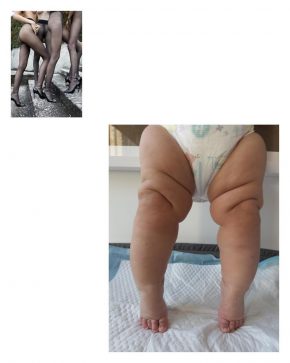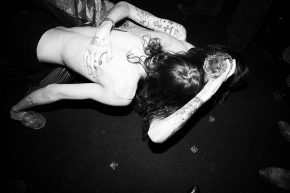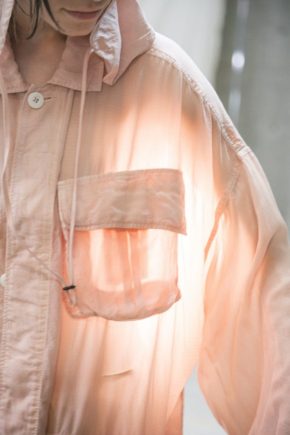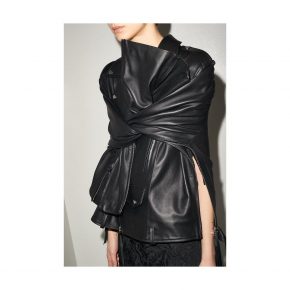Herringbone and Military Twill (FW17)

Herringbone Fabric (Silk, Wool, Linen)

0117205013016 YUKATA COAT HERRINGBONE (SI/W/LI) / BROWN
Many types of woven fabrics exist such as denim, tweed, broadcloth, dobby, dungaree, chambray, satin, and flannel, but the majority of woven products are created with one of three basic weaves: “plain weave”, “twill weave”, or “satin weave”. The names of the fabrics vary depending on the material, composition, weave, and finishing process of the thread used.
With the “plain weave”, the warp and weft are aligned so they form a simple criss-cross pattern.
Popular fabrics made with the plain weave method include broadcloth, dobby, and chambray. A “twill weave” is created by passing the weft thread over two or more warp threads and then repeating that by going over one warp thread afterwards. The main characteristic of it is that it produces diagonal lines in the fabric. Denim, tweed, dungaree, and flannel are popular types of twill weave fabrics. The “satin weave” is characterized by five weft yarns or warp yarns woven over each other, and satin is the most common type of fabric woven with this method.

Military Twill Fabric (Wool, Linen)

0117205013024 MCKINLEY JKT (MIL TWILL) / OLIVE
“Herringbone” and “twill” are two fabrics woven with the twill weave. The style of twill weave in which the weft passes over two warps and then under one is commonly referred to as a fraction such as “2/1” (two warps, one weft) and when the weft passes over three warps and then under one, it is referred to as “3/1” (three warps, one weft).
The differences between these types of weaves are the angles of the diagonal lines that form, which are called “twill lines”. “3/1” fabrics are generally called “twill”, and is most common in denim. The structure of a “2/2 twill” consists of two warp threads crossing every two weft threads. Herringbone refers to a type of fabric made with a combination of a 2/2 twill and a distinctive V-shaped weaving pattern.

The massive archive is owned by NIKKE Textile, a company with a history spanning 120 years. Pictured here is Masahiro Ohno of NIKKE Textile searching for reference items in the archive room.
Development supervisor interview (NIKKE Textile Masahiro Ohno)
Herringbone
Ohno’s development begins from meticulously observing Nakamura’s personal archives, which serve as reference materials. Where does the personality and feeling that an item possesses come from? When, where, and what kind of people wore it? What kinds of lives did they lead wearing it? Of course there are further details he learns of from listening to Nakamura’s anecdotes, but generally he reads the expressions of each individual yarn with a loupe and a pair of tweezers in hand, gradually building up the ideal image with his imagination.
This vital task requires the use of his knowledge and experience of developing various types of fabrics in the past to create and realize a specific image in his mind of how to express the same overall feel of the original inspiration piece. “The herringbone pants that I borrowed from his archives brought images of high society. I could envision an upper class gentleman wearing them. After years of aging the oil (in the yarn) has been completely removed, resulting in a very dry and seasoned texture. The fabric was woven with a relatively thick yarn, and the composition was soft and not too rigid, creating a delicate kind of material.”


The first thing he thought of was the wear and tear of the fabric, like how to recreate the distinctive bulky texture. If you weave it too firm the fabric becomes stiff, and it loses the appropriate amount of tenseness and stiffness if it is woven too loosely. “Recreating the same kind of feel and getting the proper adjustments right are extremely difficult.
If I was allowed to cut up the archive piece it’d be pretty easy for me to figure it out (laughs). But of course I know that he takes great care of all of his archive pieces, so I have to rely on my eyes to imagine the composition of the parts that are hidden underneath the surface of the fabric.”


Once he figures out a rough image of the composition, he then moves on to thinking about what type of yarn to use to comprise it. “I believe that the archived pants consisted of a two-colored warp yarn and one-colored weft yarn composition. The yarn was relatively thick and featured a mix of colors, with a slight nep count. In order to reproduce the color I dyed yarn using slightly different colors, and arranged them according to the grandrelle yarn. This created a color that looked like it had undergone a slight transformation over years of aging, resulting in a vintage feel.” Even with fabrics woven with an original composition of a two-colored warp yarn and a one-colored weft yarn, the depth of the colors would increase due to discoloration over aging and wear and tear.
What ended up being required to reproduce the increased number of colors on the newly created fabric was a four-colored warp yarn and three-colored weft yarn composition. As each color is made up of multiple colored threads, you ultimately end up with a larger number of prepared colors. “For example, I took three different types of thin yarn, made up of a spun woolen yarn made with British wool for the weft yarn, a silk nep yarn, and a linen thread to bring out the dry texture, and wove them into a single piece of yarn. The way the colors are coated differently is due to the materials they consist of, which gives off a vibrant and expressive feeling. The way it’s made is surprisingly elaborate. It’s always this way when I work with Nakamura-san, and we truly start by creating each individual piece of custom yarn.”


Once the weave composition and yarn structure is decided, we put the finishing touches on the fabric using a loom without creating multiple prototypes. “I visit the weaver here and there to see the loom. I check to make sure that the fabric is being woven as imagined. I ask them to make subtle adjustments and carefully bring it closer and closer to what we had in mind.”
How you put the finishing touches on the woven fabrics can also significantly change its overall look and feeling. Putting it through a wash and then pressing it will give you a drapey look, while another way to bring out a completely different expression is by applying a nap raising finish and softening the fabric.
“This herringbone fabric already had the right feeling at the greige (unfinished woven fabric that hasn’t been bleached or dyed) stage. It felt like it was already fairly close to what we were aiming to make. When you’re trying to create a dry, almost withered texture it’s very important not to process the fabric at the end. Ideally you remove the fabric from the loom and preserve the texture and feel in its freshly woven state. In this case the fabric tension comes out randomly from piece to piece, giving it an authentic rustic feel. If you make it too perfect it loses its expression, so I try to keep the overall roughness of the finished fabric.”

According to Ohno, this type of development and manufacturing can be conducted because there is an established clear image of the final product.
“When you make fabric too perfectly, it becomes unable to move. When the finished product reaches the customer’s hand the fabric already has a vintage feel, but from there, various aspects such as the owner’s body type and lifestyle can result in various changes. Every item has a different feeling unique to its owner, and it’s satisfying to have people enjoy this process. I feel like Nakamura-san truly pays careful attention to such details.”

Military Twill
“The inspiration for this twill fabric came from an old Japanese military jacket. It was heavily damaged with a muddled look. However, I remember that the texture of the jacket was very beautiful. Although it wasn’t an extravagant piece, it felt as though it was made with great care from the era it came from. You can almost feel the passion towards the manufacturing of the jacket; made with natural fibers during a time when materials were scarce.
I’m assuming they only had that color of yarn for the material that the jacket was made from, but it had a very rich and striking appearance. The weaves are also extremely random, and of course it was made this way, because the manufacturer was not especially skilled, but that ruggedness gives it character.”

The yarn structure is thought up after envisioning an image of the reproduced fabric. Although at first glance the fabric looks like it consists of a single color, but in fact slightly differing multi-colored yarn was used for this fabric as well. “For this fabric we devised and created a marbled grandrelle yarn. Little by little we changed the warp and weft yarns. The warp yarn was made by spinning three different types of yarn into one. We calculated the color difference between the British wool used for the weft yarn and the linen thread, added a tint and spun the three types of yarn to create a single one.” The original fabric from the archive flowed in the warp direction, and this characteristic was expressed by changing the degrees of thickness in the warp and weft yarn.
“Recreating the same expression was quite a challenge, but we twisted two types of thread for the weft yarn to make the fabric flow in the warp direction. Although this may just be my opinion, I thought that we were successfully able to produce a slightly rough texture with an almost nostalgic expression, as if a lot of time had passed since the fabric was woven. We hardly applied any finishing touches to this fabric as well, preserving its greige state.”
“I think that this one came out especially well. The texture has the perfect dry and withered look, and we really succeeded in creating an authentic vintage style feel. This is one of my favorite fabrics that we’ve made recently.”


This is the same as the “herringbone”, but only one color exists for each of the archive pieces used for reference. We stock multiple colors for each of our products, but we discussed how to proceed with the development of other colored fabrics.
“The difficult part is making sure that the texture doesn’t change when you’re creating different colored versions of the same product. I think most people think that the yarn structure and weave composition is kept the same and only the dyed colors are changed to produce the final product, but this method would change the textures of each colored fabric. For each color it’s necessary to adjust their expressions as well.”

Even when you finish a single colored fabric, it’s impossible to make the exact same fabric by simply changing the dye color. It requires you to re-think the materials and colors of the yarn and the weave composition each time you produce a new colored fabric. Creating different colors of the same fabric is in theory the same as making a new fabric for each color that possess a similar texture and feeling.
“We really do make everything starting from the yarn, so it really is tough. You usually wouldn’t do something so tedious and difficult. As a fabric manufacturer we place a heavy emphasis on creating rich textures, but when you try to recreate every little detail of an old archived item it rarely results in a product that you can put on the market. The key is what methods you take to create a quality reproduction, and although this is extremely challenging, that’s also what makes it so enjoyable.”

0117202002002 SKAGWAY LO-FOLK (WOOL HERRINGBONE) / BLACK

0117205013018 SANJURO JKT (MIL TWILL) / NAVY


























Comments